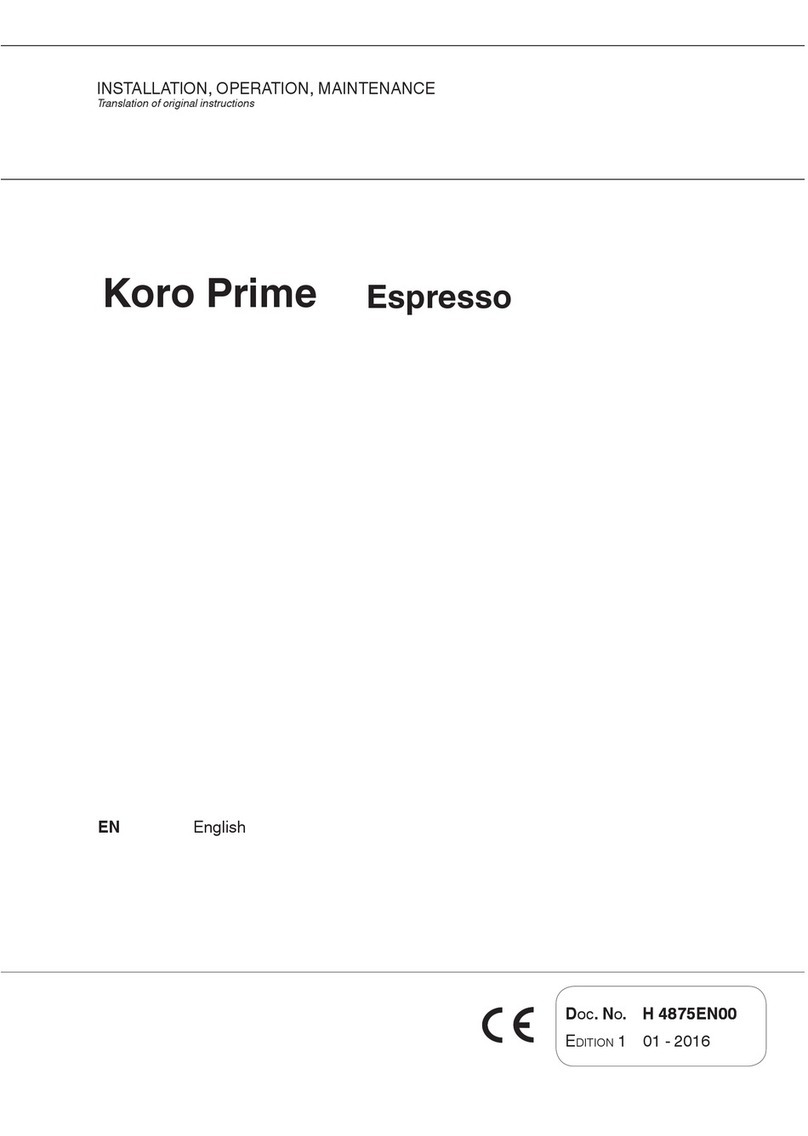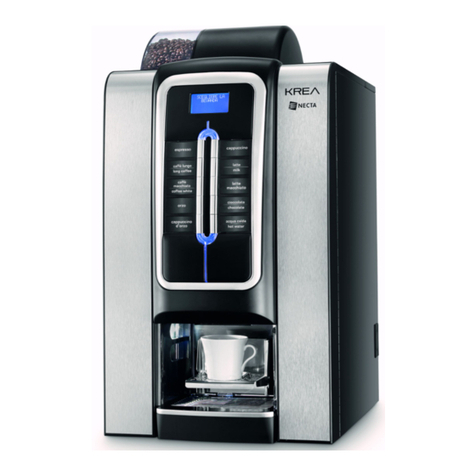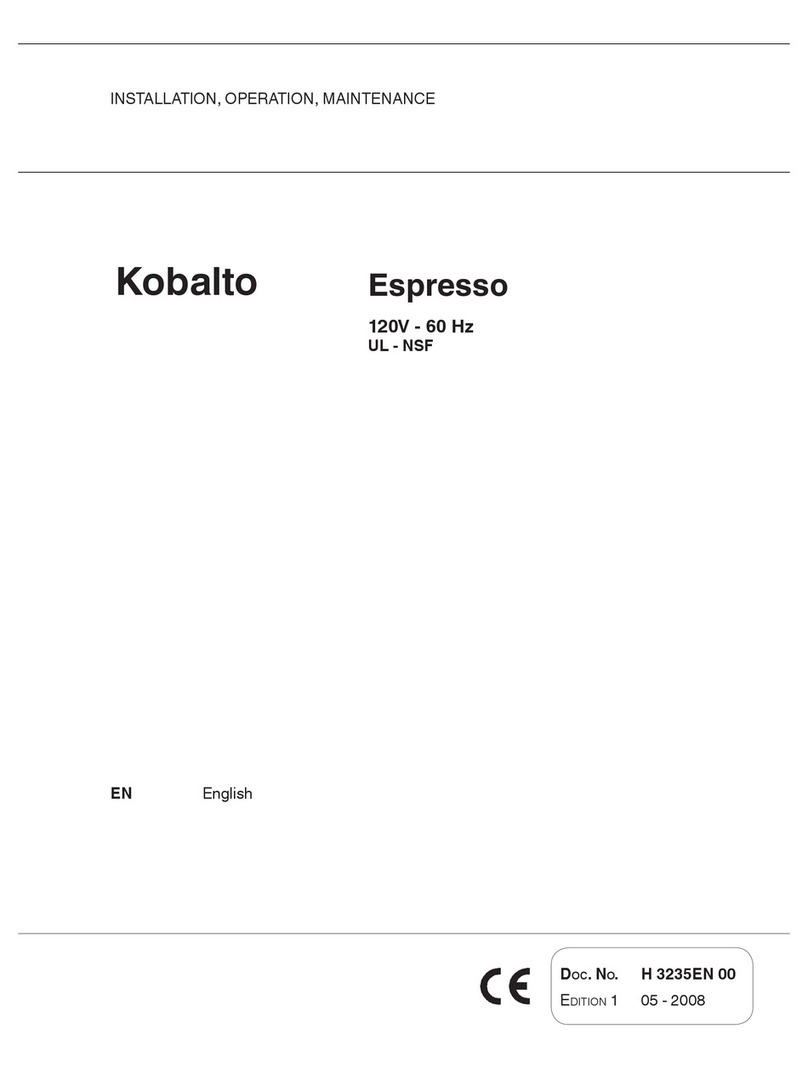1
© by N&W GLOBAL VENDING SpA 02-2007 266 00
TABLE OF CONTENTS
INTRODUCTION PAGE 2
IDENTIFICATION OF THE VENDING MACHINE PAGE 2
IN CASE OF FAILURE PAGE 2
TRANSPORT AND STORAGE PAGE 2
POSITIONING THE VENDING MACHINE PAGE 3
WARNING FOR INSTALLATION PAGE 3
PRECAUTIONS IN USING THE MACHINE PAGE 3
WARNING FOR SCRAPPING PAGE 3
TECHNICALSPECIFICATIONS PAGE 3
POWER CONSUMPTION PAGE 4
CHANGEABLE COMBINATION LOCK PAGE 5
ACCESSORIES PAGE 5
LOADINGAND CLEANING PAGE 6
DOOR SWITCH PAGE 6
CLEANING AND DISINFECTION PAGE 6
USING THE VENDING MACHINE PAGE 6
CONTROLS AND INFORMATION PAGE 7
NOISE LEVEL PAGE 7
LOADING CUPS PAGE 8
LOADING INSTANT PRODUCTS PAGE 8
LOADING COFFEE PAGE 8
SANITISING THE MIXERS PAGE 9
CLEANING THE WATER SUPPLY TANK PAGE 9
PERIODIC CLEANING OF THE COFFEE UNIT PAGE 9
CLEANING THE CUP SHIFT ARM PAGE 9
CLEANING THE SUGAR DISPENSER PAGE 9
CLEANING THE WASTE TRAYS PAGE 10
SUSPENDING FROM USE PAGE 10
INSTALLATION PAGE 11
DOOR SWITCH PAGE 11
UNPACKING THE VENDING MACHINE PAGE 11
INSERTING THE SELECTION LABELS PAGE 12
CONNECTING THE MACHINE TO
THE WATER MAINS PAGE 12
CONNECTING TO THE POWER SUPPLY PAGE 12
INSTALLING THE PAYMENT SYSTEM PAGE 13
FILLING THE WATER SYSTEM PAGE 13
WATER SOFTENER UNIT PAGE 13
OPERATION PAGE 14
PRE-SELECTIONS PAGE 14
COFFEE DISPENSING CYCLE PAGE 14
CHECKING AND ADJUSTING
THE MACHINE SETTINGS PAGE 15
SETTINGS PAGE 15
WATER TEMPERATURE CONTROL PAGE 15
IDENTIFICATION OF THE BREWER UNIT PAGE 15
ADJUSTING THE BREWING CHAMBER VOLUME PAGE 16
ADJUSTING THE GRADE OF GRINDING PAGE 16
ADJUSTING THE COFFEE DOSE PAGE 16
NOTES ON PROGRAMMING PAGE 17
NORMAL VENDING MODE PAGE 17
MAINTENANCE MENU PAGE 18
SPECIAL FUNCTIONS PAGE 18
STATISTICS PAGE 19
PROGRAMMING MENU PAGE 20
MANUAL INSTALLATION PAGE 21
RESETTING THE FAILURES PAGE 21
DISPLAYING FAILURES PAGE 21
WATER AND POWDER DOSES PAGE 22
PROGRAMMING THE PRICES PAGE 22
PROGRAMMING THE PRICES
AND THE PUSH-BUTTON STATUS PAGE 22
BASIC COIN AND DECIMAL POINT PAGE 22
PAYMENT SYSTEMS PAGE 22
INITIALISING PAGE 23
SETTING THE MACHINE CODE PAGE 23
MACHINE CONFIGURATION PAGE 24
SELECTION COUNTER PAGE 24
SETTING THE PROMOTIONAL MESSAGE PAGE 24
LANGUAGE SELECTION PAGE 24
WHIPPING TIME PAGE 24
PROGRAMMING ACCESS PASSWORD PAGE 24
SELECTION CONFIGURATION PAGE 24
SPECIAL SALES PAGE 25
SETTING DATE AND TIME PAGE 25
AUTOMATIC WASHING OF THE MIXERS PAGE 25
SETTING THE TIME BAND PAGE 25
SETTING THE TIME BAND PRICES PAGE 25
CONSECUTIVE SELECTIONS PAGE 25
PRE-GRINDING PAGE 25
TEMPERATURE SETTING PAGE 25
DISPLAY PRE-SELECTIONS PAGE 25
SYRUP PRE-SELECTION PAGE 25
SETTING THE OVERPRICE FOR SYRUPS PAGE 25
SYRUP CYCLE PAGE 25
DEX UCS - EVADTS PAGE 25
MAINTENANCE PAGE 26
ESPRESSO UNIT MAINTENANCE PAGE 26
PERIODICAL CLEANING PAGE 27
EMPTYING THE BOILER PAGE 27
PRINTED BOARD FUNCTIONS
AND INDICATOR LAMPS PAGE 28
CONTROL BOARD PAGE 28
PAYMENT SYSTEM EXPANSION BOARD PAGE 29
PUSH-BUTTON BOARD PAGE 29
HYDRAULIC SYSTEMS PAGE 30
PROGRAMMING MENU SUMMARY PAGE 31
WIRING DIAGRAMS PAGE 39
ENGLISH






























